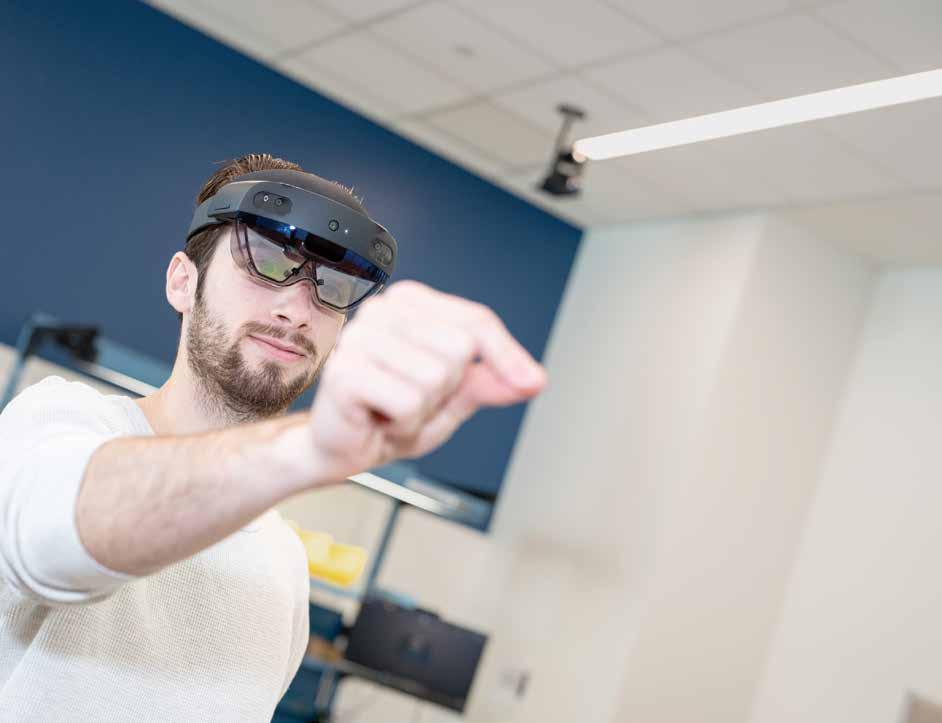
FRED DEMATTEIS SCHOOL OF ENGINEERING AND APPLIED SCIENCE


FRED DEMATTEIS SCHOOL OF ENGINEERING AND APPLIED SCIENCE
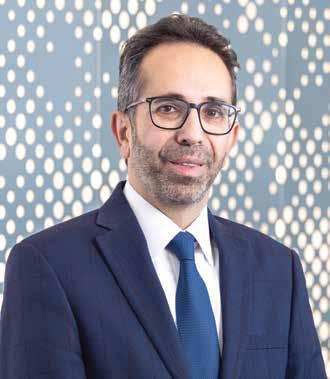
The 2024-2025 academic year marked a milestone for the Fred DeMatteis School of Engineering and Applied Science, with the highest enrollment in its history. Students and faculty now fill three dedicated campus buildings that serve as the home for all programs within our two departments: Engineering and Computer Science.
Across the pages of this viewbook, you’ll see how our expanded facilities are being used to bridge the classroom and the lab, giving students experience in a wide range of laboratory environments. One of our proudest distinctions is that all of our lab equipment — whether standard or state-of-the-art — is accessible to
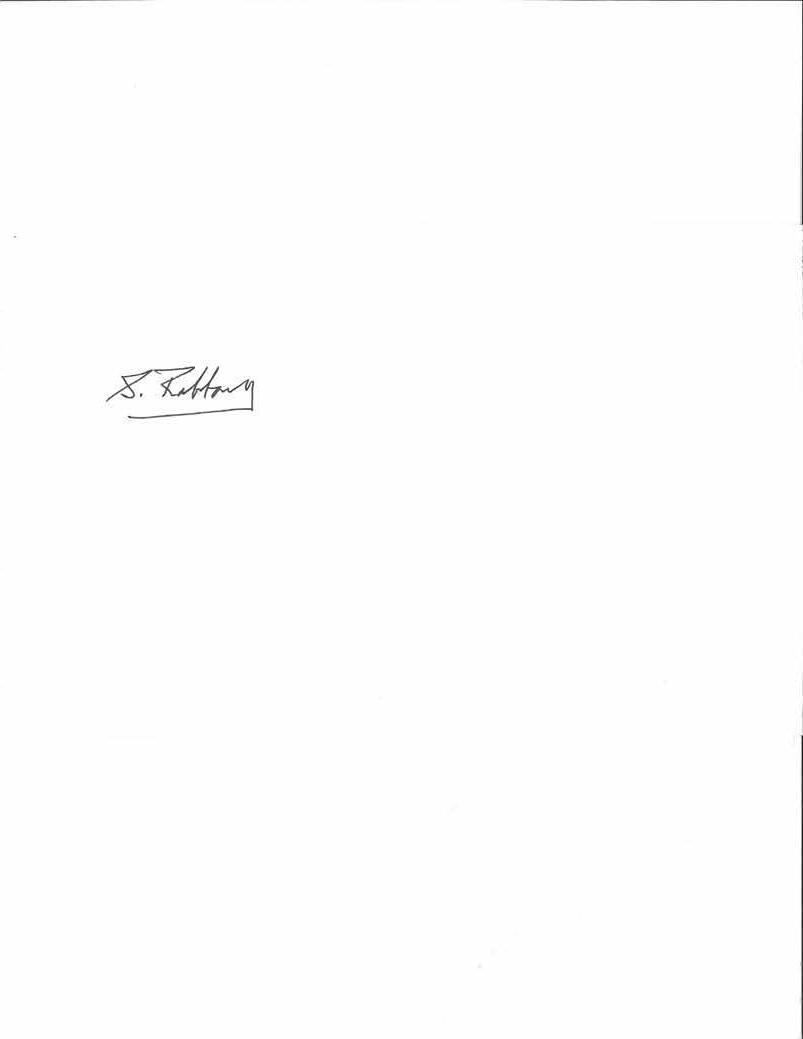
INSPIRED TEACHING:
• All classes are conducted by dedicated and accomplished faculty (not teaching assistants).
RESEARCH OPPORTUNITIES:
• Supervision and support by faculty mentors.
• Encouragement to present work at scientific conferences and/or publish in scholarly journals (see page 7).
STATE-OF-THE-ART FACILITIES:
• The Science & Innovation Center (SIC) includes classrooms, laboratories, technologies, and equipment for computer science, bioengineering, and industrial engineering. The SIC is also home to the newly launched High-Performance Computing (HPC) cluster (see page 8).
• Modern laboratories are available for students in all degree programs (see pages 14-17).
PROFESSIONAL EXPERIENCE:
• Exclusive Co-op Program – matching students with full-time salaried positions for 6-8 months.
• More than 235 corporate partners.
• Co-op experience often leads directly to full-time employment after graduation.
WELL-ROUNDED CURRICULUM:
• Enhanced education in the social and natural sciences, and the humanities – an academic and professional asset.
SUCCESSFUL ALUMNI:
• 89% of recent undergraduate degree recipients reported being employed or planning to start graduate school within one year of graduation.
• Approximately 4,000 alumni are currently working in industry, government, and academia.
FORWARD-THINKING FEEDBACK AND SUPPORT:
• Industry leaders on three DeMatteis advisory boards work with Hofstra faculty and administrators to develop dynamic courses, programs, and networking opportunities for students.
• The Women’s Summer Program in Computing/ Engineering (W-SPiCE) provides students with mentoring, workshops, events, and resources focused on women leaders in engineering and computer science
*Results are based on data collected from the Alumni Outcomes survey, LinkedIn, National Student Clearinghouse, and Hofstra enrollment (88% knowledge rate). Visit hofstra.edu/outcomes for detailed information.
Undergraduate Degrees
• Bioengineering, BS (Options: Bioelectricity, Biomechanics, or Pre-Medicine)
• Civil Engineering, BS
• Computer Engineering, BS
• Computer Science, BA; BS
• Computer Science and Cybersecurity, BS
• Computer Science and Mathematics, BS
• Data Science and Machine Learning, BS
• Electrical Engineering, BS (Option: Computer)
• Engineering Science, BE (Options: Chemistry, Environmental, or Physics)
• Human Factors and Usability Studies, BA
• Industrial Engineering, BS
• Mechanical Engineering, BS (Option: Aerospace)
Graduate Degrees
• Computer Science, MS
• Cybersecurity, MS
• Data Science, MS
• Engineering Management, MS
Dual-Degree Programs
• Computer Science, BS/MS
• 4+4 Program: BS-BA/MD (with the Zucker School of Medicine at Hofstra/ Northwell)


Laboratories include:
• 3D Printer Makerspace
• Advanced Applications
• Advanced Communications
• Aerodynamics Research
• Applied Science Design & Fabrication Workshop
• Big Data
• BioElectronics and Medical Instrumentation
• Cell and Tissue Engineering
• Civil Engineering
• Computer Architecture, Embedded Systems, and Mobile Computing
• Cybersecurity Innovation and Research Center
• Electrical Engineering
• Electromagnetics
• Energy
• Environmental Engineering
• First-Year Engineering
• Fluid Dynamics
• Geotechnical Engineering
• Industrial Engineering
• Intelligent Systems
• Linux
• Materials Analysis
• Robotics and Advanced Innovation
• Structures
• Sustainable Discovery
• Systems and Graphics
• Ultrasound Research
• Vibrations Analysis Research
• Virtual Reality At Hofstra, students have access to cutting-edge technology and modern labs that bring engineering and computer science to life. Whether you’re diving into experiments, conducting breakthrough research, or mastering industry-grade tools, our top-tier equipment is here to power your innovation and creativity.

At the Fred DeMatteis School of Engineering and Applied Science, faculty and students are making groundbreaking strides in research, earning national and international recognition for their contributions.
Two DeMatteis professors were honored for their pioneering work in computer science this academic year.
Dr. Marco Romanelli, assistant professor of computer science, was named a finalist for the 2024 Italian Scientist and Scholars in North America Foundation (ISSNAF) Young Investigator Award for his research titled Trustworthy Machine Learning: An Information-Theoretic Perspective. His work tackles key challenges in artificial intelligence (AI), focusing on security, transparency, and ethics.
“This recognition strengthens my commitment to research in secure, ethical AI,” Romanelli said. “I plan to use it to foster collaborations, attract talented students, and secure funding — amplifying our impact in AI and cybersecurity research.”
Dean Sina Rabbany praised Romanelli’s work: “Dr. Romanelli exemplifies the kind of forward-thinking research that prepares our students for impactful careers.”
Dr. Krishnan Pillaipakkamnatt, professor of computer science, was honored with the Tech Teacher award at the 2024 Long Island SummIT Awards (LISA), hosted by the Long Island Software and Technology Network (LISTnet).
“Receiving this award is a tremendous honor,” Pillaipakkamnatt said. “It reaffirms the importance of fostering curiosity, resilience, and a passion for technology in the classroom. I’m grateful to be part of Hofstra, where innovation and education thrive together.”
Dean Rabbany added, “Dr. Pillaipakkamnatt’s dedication to his students and his pioneering teaching methods reflect the high standards we uphold at the DeMatteis School.”
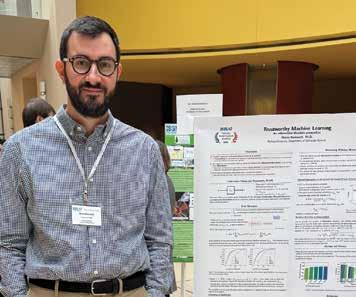

Hofstra students are also gaining recognition for research that is shaping the future.
Edward Guo ‘25, a computer science student from Northborough, Massachusetts, became the first Hofstra student to present research at the EuroSys 2025 Conference in the Netherlands. Under the mentorship of Dr. Jianchen Shan, associate professor of computer science, Guo developed a method to improve cloud computing systems, achieving speeds up to 200% faster and 1.8 times lower latency in task scheduling for virtual machines.
“Edward Guo’s achievements showcase the kind of education and mentorship we foster at the DeMatteis School,” Dean Rabbany said. “We provide the resources and support that enable students to push boundaries — not just academically, but in ways that impact real-world innovation.”
Guo credits his success to hands-on research experiences and faculty mentoring. “As long as you’re passionate and willing to work, opportunities will come,” he said. “Being proactive and seeking mentorship has opened so many doors for me.”
Rahul Ramanathan, a second-year medical student at the Zucker School of Medicine at Hofstra/Northwell, co-authored a groundbreaking study published in Microcirculation. His research, in collaboration with DeMatteis Associate Dean David Rooney and Dean Rabbany, explores blood flow dynamics in microvascular networks, advancing personalized medicine.
“This work highlights the powerful impact interdisciplinary collaboration can have on advancing our understanding of complex biological processes,” Dean Rabbany said.
Rooney emphasized the value of early research experience: “By working on complex projects, students learn to apply theoretical knowledge in practical ways, gaining insights that set them apart in both academic and clinical fields.”
Reflecting on his experience, Ramanathan said, “Having access to a cell and tissue engineering lab where I could practice biological research techniques and apply my engineering degree was critical for my future.”

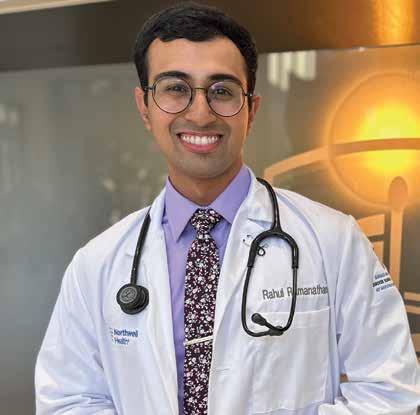
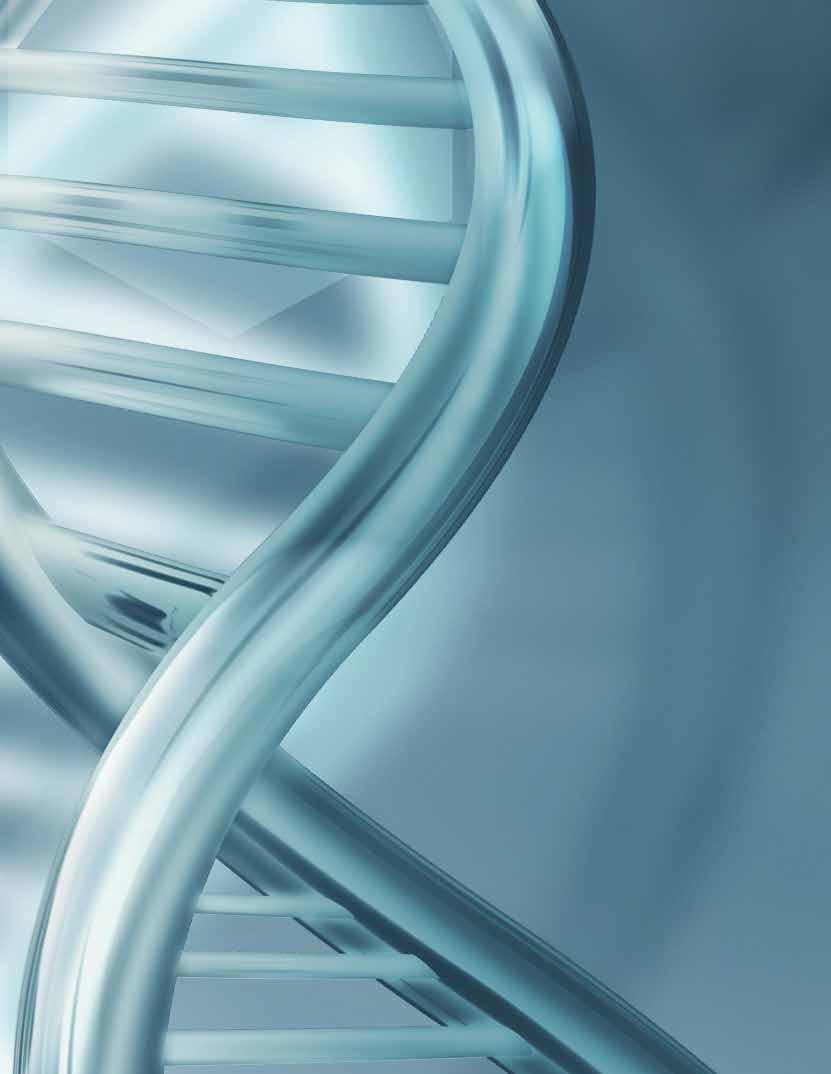
Hofstra University launched a state-of-the-art HighPerformance Computing (HPC) cluster, housed within its $4 million data center in the Science & Innovation Center. More than five years in the making, the powerful system supports artificial intelligence (AI), machine learning (ML), and data-intensive applications across multiple disciplines — benefiting not only Hofstra but also researchers at Adelphi University and Nassau Community College.
Equipped with high-demand NVIDIA GPUs, hundreds of AMD EPYC and Intel Xeon processor cores, over 7 terabytes of RAM, and high-speed flash storage, the cluster is built to handle complex computations, largescale simulations, and massive datasets. This technological leap will accelerate research in fields such as biology, chemistry, physics, neuroscience, computer science, and engineering.
“This HPC cluster represents a major milestone for Hofstra University and our partners,” said Dean Sina Rabbany, Fred DeMatteis School of Engineering and Applied Science. “It will significantly expand the scope of research and education across multiple disciplines, enabling us to address some of the most complex and transformative scientific challenges.”
The initiative was spearheaded by Edward Currie, associate professor of engineering, and Alexander Rosenberg, manager of systems and operations, both of whom emphasize the far-reaching impact of the HPC cluster on both research and education.
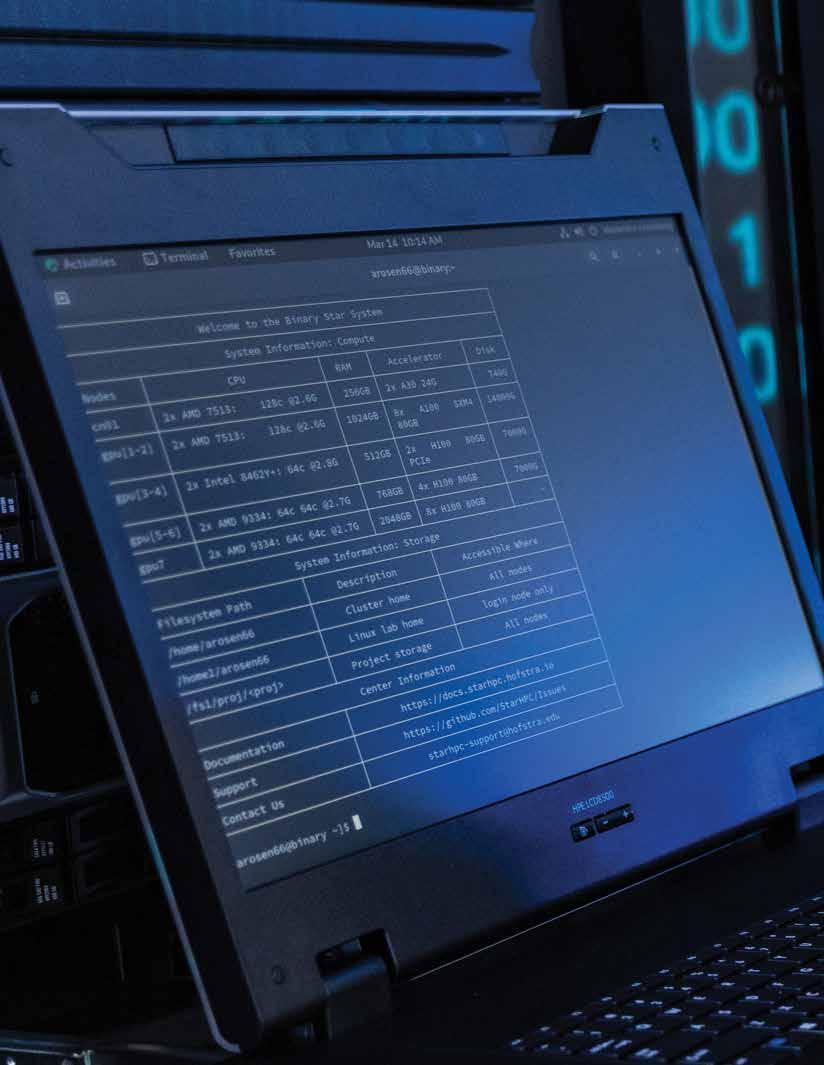
“The HPC cluster will open doors for AI and ML research that previously required external resources,” Currie said. “Whether studying molecular structures or advancing quantum computing models, this tool will be an essential asset for research, teaching, student projects, and discovery. We are particularly excited about the AI and ML opportunities it will create for undergraduate students to engage in hands-on, high-level computational experiments.”
Beyond research, the cluster will be a valuable teaching tool, allowing faculty to integrate high-performance computing into their courses and giving students hands-on experience with industry-standard technology. This exposure will better prepare them for careers in data science, computational engineering, and AI-driven industries.
The HPC cluster marks a new era of technological advancement at Hofstra, aligning with Hofstra 100, the University’s strategic plan to expand its research and scholarly activities. This investment reinforces Hofstra’s R2 designation as a doctoral university with high research activity, a distinction held by institutions that demonstrate significant commitment to cutting-edge research.
By providing researchers and students with access to world-class computing power, Hofstra is strengthening its position as a hub for technological innovation. As AI, ML, and data science continue to reshape industries, this investment ensures that Hofstra students and faculty remain at the forefront of these transformative fields. Whether solving modern problems or pioneering breakthroughs in science and engineering, the possibilities are limitless.


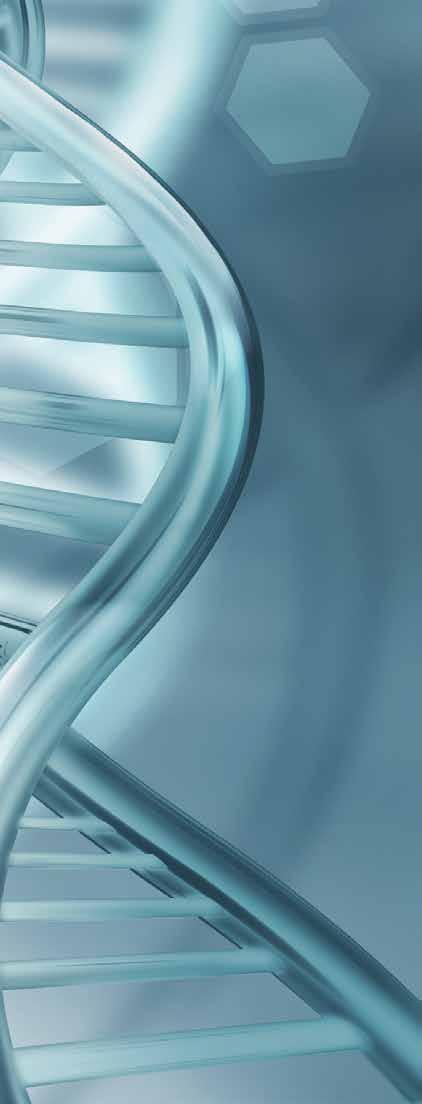
Hofstra computer science students Gayathri Suresh ‘25 of New Hyde Park, New York, and Rohit Poolust ‘25 of Bellerose, New York, are using the University’s new HighPerformance Computing (HPC) cluster to power a mobile app that aims to improve early detection of skin cancer.
Designed to identify basal and squamous cell carcinoma, two of the most common non-melanoma skin cancers, the app features a lesion-tracking tool and a machinelearning algorithm that analyzes color, texture, and border irregularities. It’s designed to be accessible, free, and user-friendly — removing financial barriers to early screening.
The project, part of their senior design course, merges their interests: Gayathri is on the pre-med track and will attend the Zucker School of Medicine at Hofstra/Northwell, while Rohit is focused on machine learning and data science.
“The machine-learning component is the cornerstone of our project,” Gayathri said. “We couldn’t do this without the cluster.”
Their project highlights the transformative potential of the HPC cluster, which is helping students apply cuttingedge tools to solve practical problems and preparing them for success in tech, medicine, and beyond.

From the labs of Long Island to the mountains of Eswatini, students in Hofstra University’s Fred DeMatteis School of Engineering and Applied Science spent their summer breaks applying classroom knowledge to modern-day challenges — developing technical skills, gaining global experience, and shaping the future of engineering and technology.
The Advanced Summer Program in Research ( ASPiRe), Break Through Tech, and OverSEAS are part of the school’s commitment to bridging academic theory with hands-on learning. “We take great pride in the fact that we offer these funded, immersive programs,” Dean Rabbany said. “They lay the groundwork for future pursuits, whether that be graduate school or contributing to innovation and discoveries for society.”
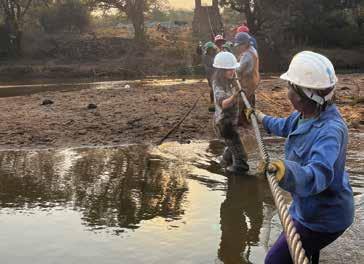
Whether working with local faculty, collaborating with peers abroad, or contributing to national initiatives, students in the DeMatteis School’s summer programs gained more than technical knowledge — they discovered how to use their skills to serve others, innovate boldly, and lead with purpose.
ASPiRe hosted its eighth annual symposium in August 2024, showcasing the work of 22 undergraduate students who spent 10 weeks investigating solutions to complex problems in engineering and computer science.

Shannon O’Brien ‘25, a mechanical engineering major from Middletown, New York, explored safety disparities in vehicle crash testing. Prompted by a friend’s car accident, her research highlighted how crash test standards underrepresent female body types. “Women are disproportionately injured in car accidents,” O’Brien said. “The required crash test dummies don’t reflect the diversity of women’s bodies.”
Mentored by Lynn Albers, assistant professor of engineering, O’Brien sought to address a critical issue in design equity. “Shannon’s passion drove this project,” Albers said. “Helping her grow as a researcher was a rewarding experience.”
Other ASPiRe students tackled similarly meaningful challenges — from optimizing plant-based vascular grafts to testing the durability of concrete. The program culminated in a symposium where students presented their findings to faculty and peers, celebrating their growth as researchers and problem-solvers.
While some students were deep in lab experiments, others were gaining new skills in artificial intelligence through Hofstra’s partnership with Break Through Tech, a national initiative led by Cornell Tech to boost gender diversity in the tech sector.



Over the past two summers, Hofstra has hosted dozens of young women who engaged in AI training and mentorship, learning to code, design algorithms, and envision careers in emerging technology fields. The year-round program includes 10 hours per week of instruction and concludes with a $2,000 award for each participant.
With the support of a $273,000 grant from the National Science Foundation, the program will now expand its reach. “The NSF funding allows us to solidify our role in expanding training opportunities for women who aspire to join the AI workforce,” Dean Rabbany said.
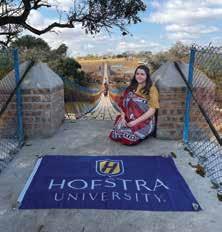
For civil engineering student Anastasia Moore, hands-on learning took her more than 8,000 miles from Hofstra to Eswatini, a small country in southern Africa. There, as part of the DeMatteis OverSEAS program, she worked with Engineers in Action to build a pedestrian bridge that now provides local residents with safe access to clean water and food.
“Our days were long and filled with challenges,” Moore recalled. “But seeing the kids running across the bridge and knowing the difference it would make — it’s something I’ll never forget.”
Moore took on multiple roles, from logistics to design, and discovered a passion for construction management. “I met people from different countries and industries. It was inspiring and clarified my career aspirations.”
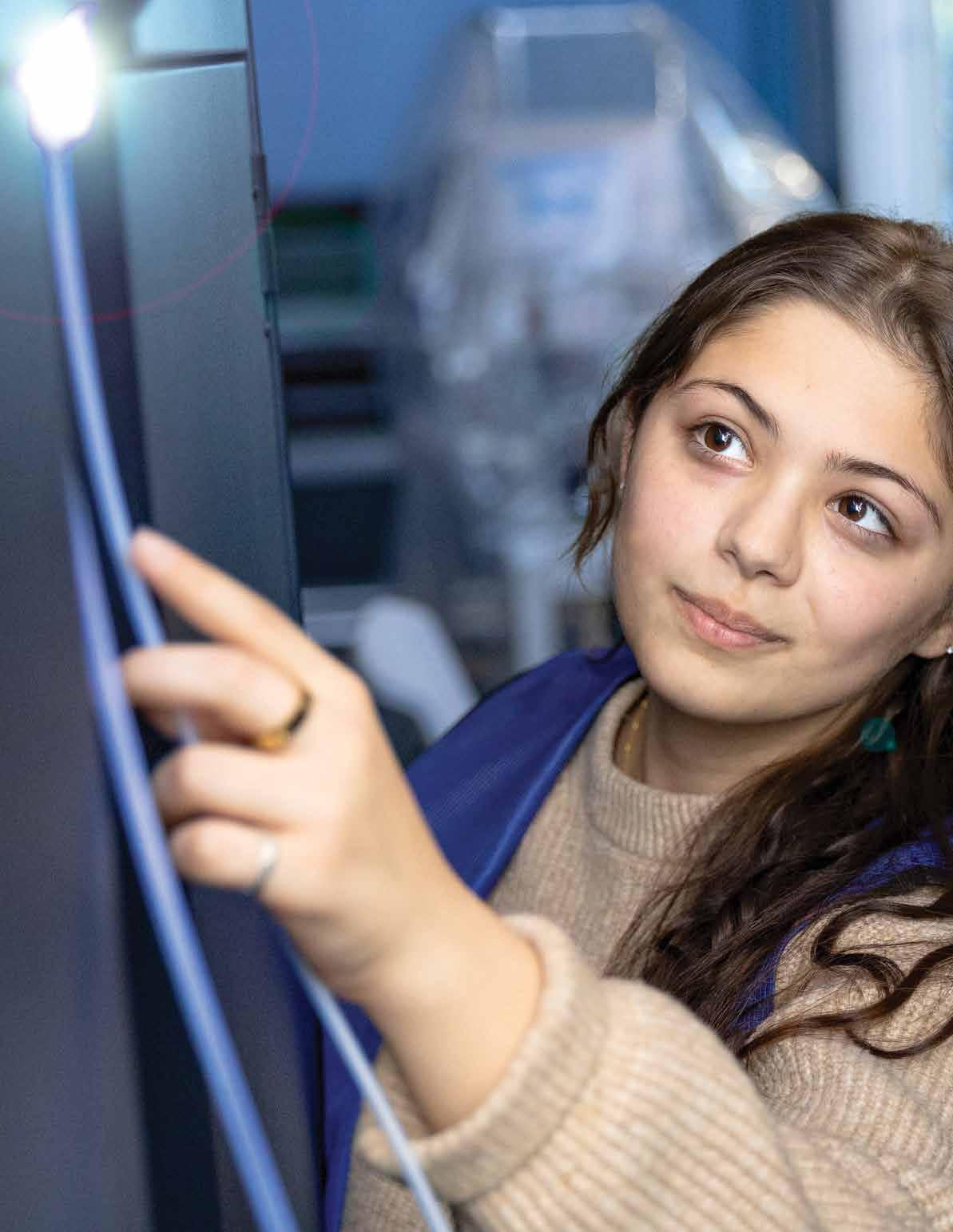
97% of full-time professors hold the highest degrees in their field
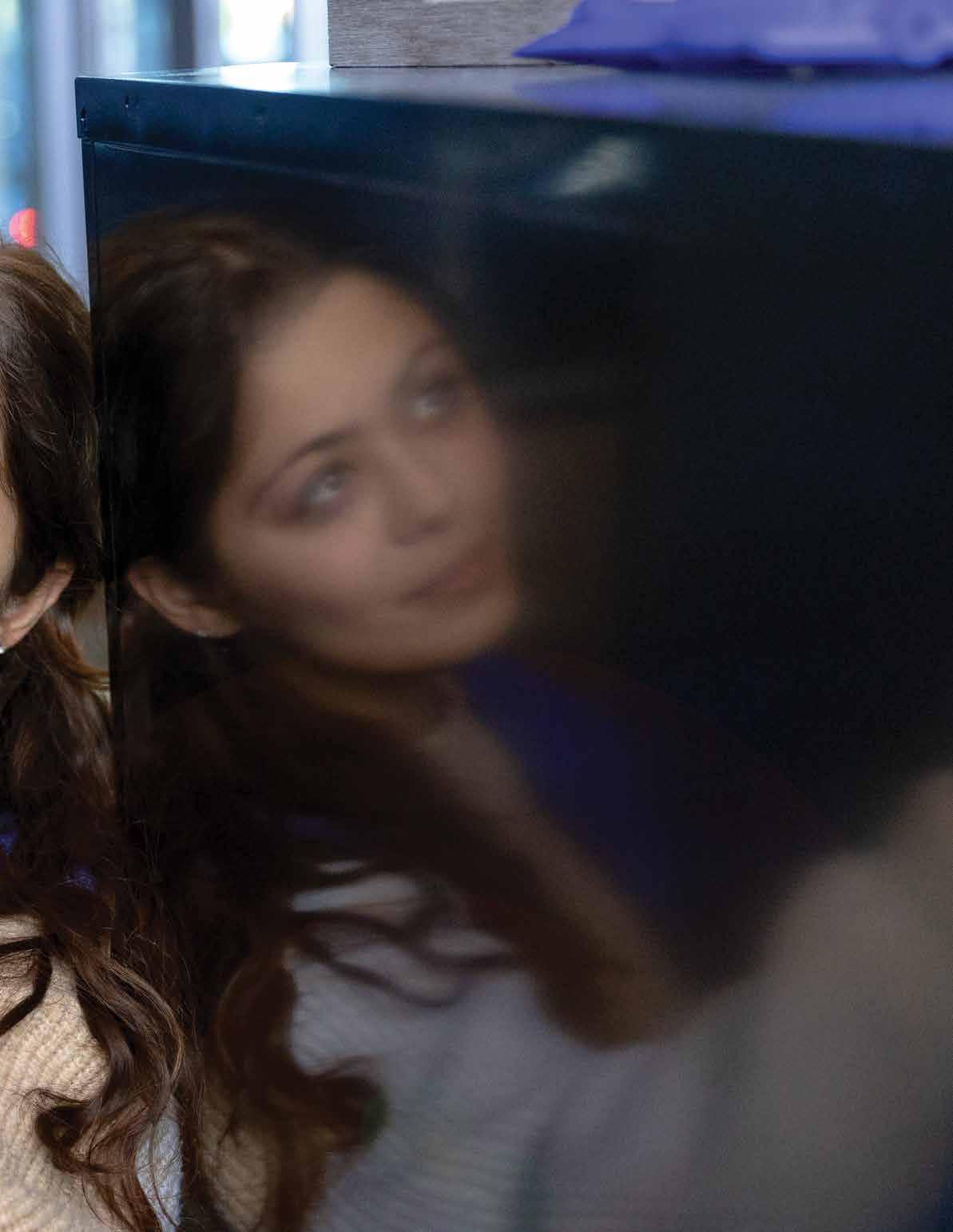
842 undergraduate students
27% female students
235+ co-op partners
112 graduate students
TOP 11% in the nation among 286 non-PhD-granting engineering schools (U.S. News & World Report, Best Colleges rankings, 2025)
954 total students
4 master’s degree programs
7 ABET-accredited* undergraduate degree programs
5000+ alumni
BIOENGINEERING –SCIENCE & INNOVATION CENTER
This state-of-the-art lab provides students with sophisticated biomedical tools for tissue engineering, biomechanics, and medical device development. With access to advanced imaging systems, 3D bioprinters, and cell culture equipment, students gain hands-on experience in designing healthcare solutions — preparing them for careers in biomedical research, biotechnology, and healthcare innovation.


CIVIL ENGINEERING / SOIL MECHANICS –ADAMS HALL


In this lab, students work with modern geotechnical testing equipment to analyze soil strength and conduct water quality assessments in adjacent facilities. From concrete and soil testing to structural modeling, this space offers practical applications in civil and environmental engineering. Students graduate with the skills needed for careers in construction, transportation, and sustainable design.






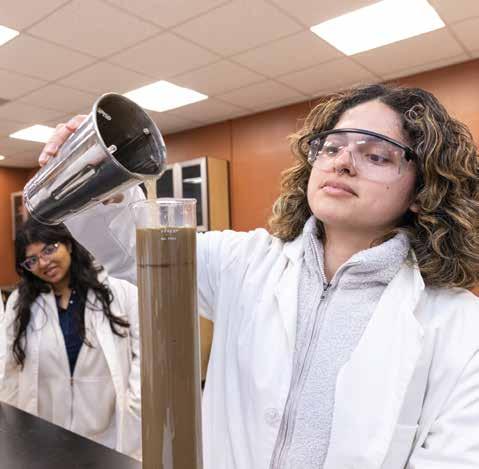


Equipped with industry-standard hardware and software, this lab enables students to explore embedded systems, circuit design, and digital logic. Hands-on experience with microcontrollers, FPGA boards, and robotics platforms ensures that graduates are wellprepared for careers in embedded systems, automation, and telecommunications.







This high-tech lab immerses students in cybersecurity, offering access to AI-driven security tools, ethical hacking platforms, and cloud computing resources. It features 36 computers, a dedicated server room, and real-time status boards used to manage cybersecurity operations. Training in network security, cryptography, and big data analysis equips students to tackle cybersecurity challenges in industries such as finance, government, and technology.


AERODYNAMICS –ADAMS HALL
This lab fosters research and experimentation in fluid mechanics, with a special emphasis on aerodynamics. It houses two subsonic wind tunnels and a supersonic wind tunnel for examining shock waves. Additional hands-on experiences with open-channel flows, pipe flows, and flow visualization experiments provide students with a comprehensive understanding of air and water flow phenomena — preparing them for careers in aerospace, HVAC, and mechanical engineering design.




INDUSTRIAL ENGINEERING –SCIENCE & INNOVATION CENTER
With automation tools, simulation software, and quality control systems, this lab helps students optimize production processes and enhance efficiency. Through hands-on training in lean manufacturing, motion studies, operations research, and logistics, students develop the expertise needed for careers in supply chain management, manufacturing, and systems engineering.


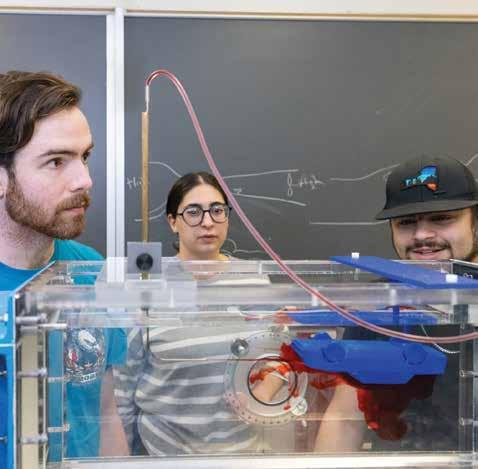



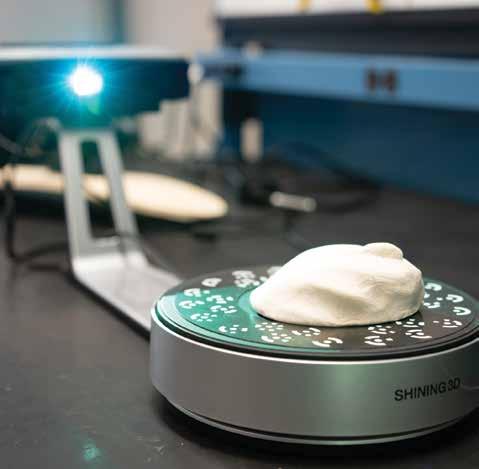


MATERIALS SCIENCE –WEED HALL
This cutting-edge lab is equipped with a full suite of materials testing systems, allowing students to study material properties, stress testing, and failure analysis. Using scanning electron microscopes, tensile testing machines, and CAD software, students gain practical skills for careers in automotive, aerospace, and product design industries.


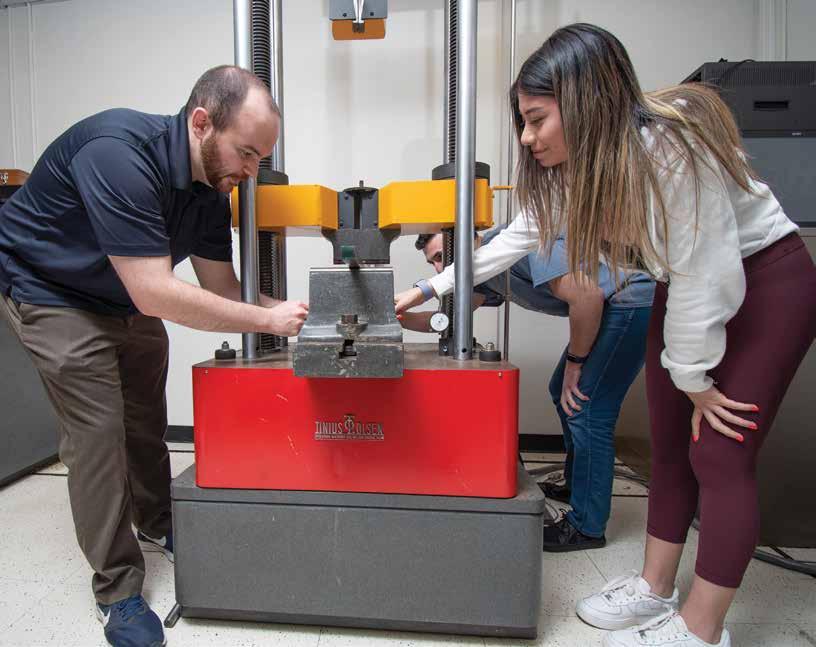



Hofstra University’s Office for Development and Alumni Affairs hosted two interdisciplinary panel discussions featuring accomplished alumni working at Goldman Sachs and Google. These events provided students with firsthand career insights, emphasizing the importance of networking, interdisciplinary collaboration, and adaptability in the workforce.
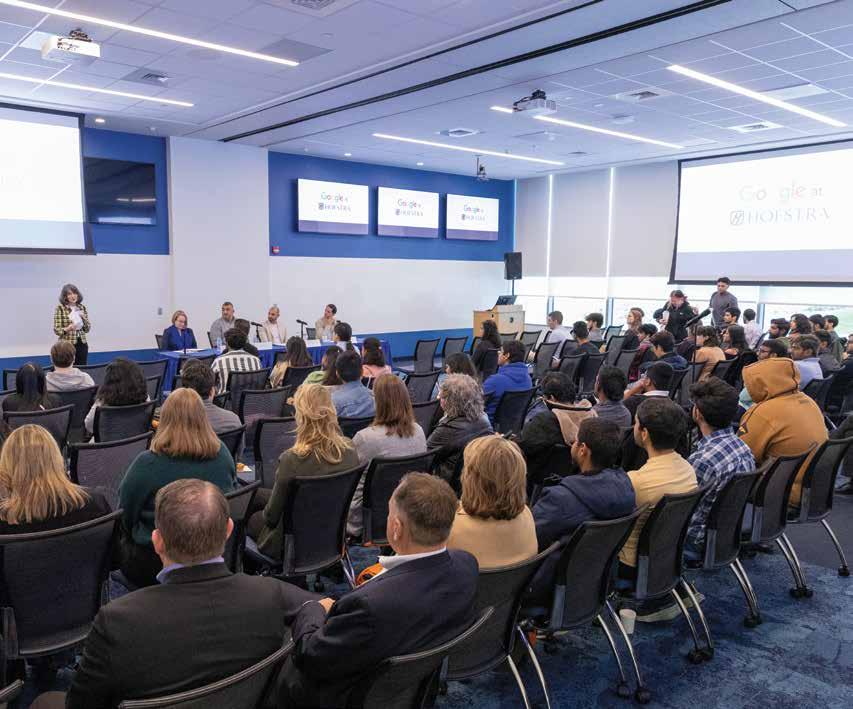
Hofstra President Susan Poser highlighted how leading employers seek a variety of educational backgrounds. “An interesting thing about our alumni panelists is that they didn’t all study finance. There are computer science and cybersecurity majors, as well as a law school graduate,” she noted at the Goldman Sachs event. Similarly, during the Google discussion, she told students, “These alumni at Google come from three different schools. That should be a message to you that cutting-edge employers like Google are not necessarily looking for one kind of expertise, major, or background.”
DeMatteis School Dean Sina Rabbany emphasized how Hofstra’s educational approach prepares students for roles across industries. “Almost one-third of employees at Goldman Sachs, which is known as a financial company, are engineers and computer scientists. Through interdisciplinary offerings, Hofstra prepares students not only for their careers but also to work with people from different disciplines and learn how to break down silos.” He continued: “Having our students hear directly from professionals at Google, especially alumni who once stood where they are now, is invaluable. It offers them a unique perspective on what it takes to succeed in a competitive and innovative environment.”
Speakers at both events emphasized that there is no single path to career success. Jason Savarese (HCLAS ’95), Goldman Sachs partner and global division head, as well as a Hofstra trustee, advised students, “There’s no one path [to career success]. Have some sense of direction, but be flexible about your plans.”
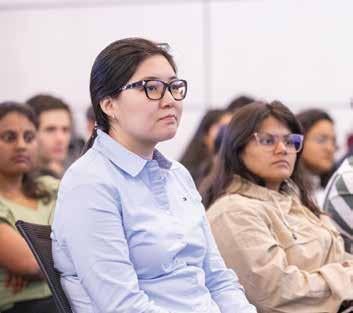
Google’s Danny Pellegriti (Zarb ’00) shared a similar perspective: “It’s been an incredible journey, and it has definitely not been linear. … I would encourage anyone … not to think that you need to have your decision made on what you’re going to do for the rest of your life.”
Panelists from both companies also highlighted the importance of interdisciplinary collaboration. Google’s Sajed Sahni (DeMatteis ’02) explained, “To me, Google culture means a lot of things. It means collaboration. It means challenging status quo. It means approaching problems from different perspectives, not just strictly one mindset.”
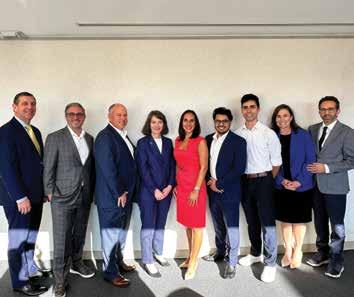
THE ROLE OF NETWORKING AND HANDS-ON EXPERIENCE
Building strong professional relationships was another key takeaway. Goldman Sachs’ Giuseppe Lo Piccolo (Zarb ’93, ’00) told students, “You’re building your network for your future, not for right now. The relationships you build now with your fellow Hofstra classmates are what you will lean on in two, five, or 10 years.”
Google panelists echoed this advice, stressing the value of gaining pratical experience early. Sahni advised students, “Go get an internship, apply for a co-op, and get real-life experience sooner rather than later. You’ll get exposed to these things much quicker, and that’ll add value when you’re ready to go into the workforce.”
By connecting students with successful alumni, Hofstra continues to provide a foundation for career achievement in finance, technology, and beyond.
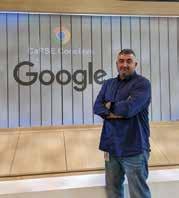
Head of Presales Engineering & Services, Americas, Google
Sajed Sahni always had a passion for problem-solving, but it was the rigorous academics and hands-on experiences at Hofstra University’s Fred DeMatteis School of Engineering and Applied Science that transformed him into a leader in the field.
As a student, Sahni immersed himself in the DeMatteis School’s Co-op Program, where he gained real-world experience that set him apart in the job market. “The Co-op Program was invaluable,” he said. “It gave me practical skills, industry connections, and a competitive edge before I even graduated.”
“It’s where I found my passion and turned it into a career.”
Beyond the classroom, Sahni took full advantage of state-of-the-art research labs, faculty mentorship, and interdisciplinary projects that challenged him to think critically and adapt quickly — key skills that continue to shape his career today.
Now an accomplished engineer, Sahni credits Hofstra’s collaborative learning environment for preparing him to tackle complex challenges with confidence. “DeMatteis didn’t just teach me engineering principles; it taught me how to innovate, work in teams, and lead,” he said.
Whether developing cutting-edge technology or mentoring the next generation of engineers, Sahni embodies the excellence and ingenuity that define DeMatteis graduates. “Hofstra prepared me for success in every way,” he said. “It’s where I found my passion and turned it into a career.”
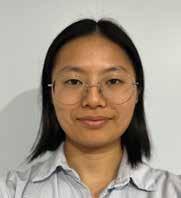
Bridge Engineer at HNTB
As a bridge engineer, Lillian Moy’s work is technical and precise. The foundation of her success was laid at Hofstra University’s Fred DeMatteis School of Engineering and Applied Science, where hands-on learning and mentorship helped her bridge the gap between classroom and theory and practical application.
“Hofstra helped me find my direction.”
“Statics was the class that really stuck with me,” Moy said. “It introduced me to the concept of equilibrium and gave me the chance to design and build a tensegrity structure – something I still think about in my day-to-day work.”
While the complexity of bridge engineering brought early moments of self-doubt, Moy said her Hofstra education gave her the confidence and clarity to move forward. Multiple internships and a research project with Dr. Edward Segal, associate professor of engineering, helped her discover her passion for design and chart a path toward licensure and graduate study.
“My time at DeMatteis was invigorating and stress-free,” Moy said. “It gave me the technical foundation I needed, but also the space to explore, collaborate, and grow.”
From late nights in the engineering workshop to constructing cardboard boats with SWE and ASME peers, Moy’s favorite memories are grounded in teamwork, creativity, and community. Now, as she looks ahead to a master’s degree and professional licensure, she’s grateful for the launchpad DeMatteis provided. “Hofstra helped me find my direction,” she said. “It’s where I learned to build and believe in myself.”

Manager, Analytics Engineering at Major League Baseball
George Calvo brings data to life for one of the most iconic brands in sports – Major League Baseball. As manager of analytics engineering, he creates tools and reports used by all 30 clubs, but the spark for his career began in a Hofstra classroom.
“A first-year seminar on the Traveling Salesman Problem changed everything,” Calvo said. “That class ignited my love for computer science, and with the support of my mentor, I found my path.”
“Hofstra challenged me, inspired me, and shaped me into who I am today.”
Calvo honed his skills in the computer lab and developed his leadership voice as the founder and president of Hofstra’s Habitat for Humanity chapter. Those experiences – paired with internships, a programming role at MEC Global, and the relationships he built – laid the foundation for his career in data and business intelligence.
At MLB, Calvo has already made his mark by leading the rollout of the league’s next-gen business intelligence platform.
“Knowing I’ve contributed to an organization like MLB is something I’ll cherish forever,” he said.
Calvo remembers his time at Hofstra fondly, specifically the moment he was crowned Fall Festival king. It was an honor to represent my class,” he said. “But the real highlight was the community – classmates, mentors, and teammates who helped me grow.”
Distinguished is the word Calvo uses to describe his alma mater. “Hofstra challenged me, inspired me, and shaped me into who I am today.”
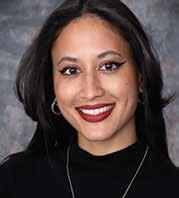
Entry-Level Civil Engineer, AECOM
PAVING THE WAY WITH PURPOSE
As an entry-level civil engineer at AECOM, Sierra Mahabir helps shape the future of transportation – working on everything from ADA compliance to bridge rehabilitation and roadway upgrades. Originally from Trinidad, her journey began at the Fred DeMatteis School of Engineering and Applied Science, where she gained the technical foundation and resilience to thrive.
“My time at Hofstra really taught me how to problem-solve, ask questions, and manage time effectively,” Mahabir said.
Mahabir landed her role at AECOM thanks to the DeMatteis School’s Co-op Program and Career Center resources. She also completed her honors thesis with Dr. Edward Segal, associate professor of engineering, an experience that taught her persistence and grit. Mahabir credits small class sizes, patient faculty, and supportive mentors with building her confidence and guiding her through moments of imposter syndrome. “I always asked a lot of questions, and they never made me feel like I was asking too many,” she said.
“Hofstra helped me discover what I’m capable of – both professionally and personally.”
One of her favorite memories while at Hofstra was grabbing food at Au Bon Pain with her senior capstone team. “We’d laugh, vent about classes, and support each other – that made the work so much more meaningful,” she said.
Now, Mahabir is focused on expanding her skills in roadway and drainage design while nurturing her creative passions like fashion and Latin dance. “Hofstra helped me discover what I’m capable of – both professionally and personally.”
Lynn A. Albers (PhD, North Carolina State University) Assistant Professor Mechanical Engineering
M. David Burghardt (PhD, University of Connecticut) Professor Mechanical Engineering
Mauro J. Caputi (PhD, Virginia Tech) Associate Professor Electrical Engineering
Kevin C. Craig (PhD, Columbia University) Director, Center for Innovation Professor Mechanical Engineering
Edward H. Currie (PhD, University of Miami) Associate Professor Electrical Engineering
Roche C. de Guzman (PhD, Wayne State University) Associate Professor Bioengineering
Sleiman R. Ghorayeb (PhD, Iowa State University) Professor Electrical Engineering
Saryn R. Goldberg (PhD, Stanford University) Associate Professor Mechanical Engineering
Margaret A. Hunter (PhD, Rice University) Assistant Chair Department of Engineering Associate Professor Civil Engineering
Wing C. Kwong (PhD, Princeton University) Professor Electrical Engineering
Nicholas J. Merna (PhD, University of California, Irvine) Associate Professor
Bioengineering
Manuel J. Miranda (PhD, Columbia University) Associate Professor Civil Engineering
Richard J. Puerzer (PhD, University of Pittsburgh) Chair, Department of Engineering Associate Professor
Industrial Engineering
Sina Y. Rabbany (PhD, University of Pennsylvania) Dean, Fred DeMatteis School of Engineering and Applied Science Professor Bioengineering
Simona Doboli (PhD, University of Cincinnati) Professor Computer Engineering
Xiang Fu (PhD, University of California, Santa Barbara) Professor Computer Science
Zonghua Gu (PhD, University of Michigan) Associate Professor Computer Science
Scott M. Jeffreys (MS, Adelphi University) Graduate Program Director Special Associate Professor Computer Science
Gerda L. Kamberova (PhD, University of Pennsylvania) Chair, Department of Computer Science Professor Computer Science
Chuck C. Liang (PhD, University of Pennsylvania) Professor Computer Science
Gretchen Ostheimer (PhD, Rutgers University) Professor
Computer Science
Krishnan Pillaipakkamnatt (PhD, Vanderbilt University) Professor
Computer Science
Salvador Rojas-Murillo (PhD, University of Iowa) Associate Professor Industrial Engineering
David M. Rooney (PhD, North Carolina State University) Professor Mechanical Engineering
Edward M. Segal (PhD, Princeton University) Associate Professor Civil Engineering
Minjeong Suh (PhD, Yale University) Assistant Professor Engineering Science
Gozde Ustuner (PhD, Stony Brook University) Assistant Professor Mechanical Engineering
John C. Vaccaro (PhD, Rensselaer Polytechnic Institute) Associate Professor Mechanical Engineering
D. Elliott Williamstyer (PhD, Cal Tech)
Assistant Professor Electrical Engineering
Marco Romanelli (PhD, Ecole Polytechnique, Paris) Assistant Professor Computer Science
Oren Segal (PhD, University of Massachusetts Lowell) Associate Professor
Computer Engineering
Simon Shamoun (PhD, CUNY City College)
Special Associate Professor
Computer Science
Jianchen Shan (PhD, New Jersey Institute of Technology)
Associate Professor Computer Science
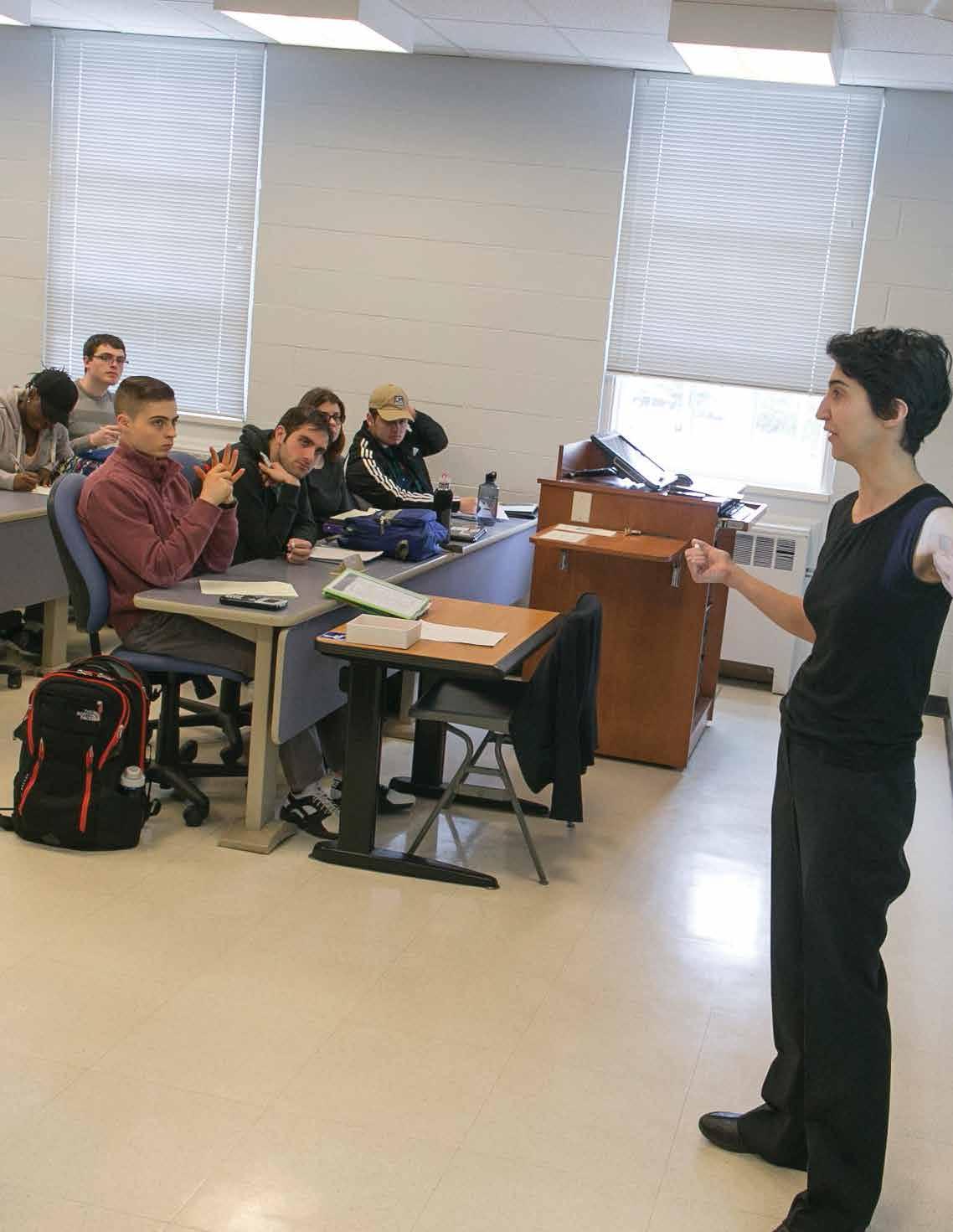


Dennis Ashby, BS, ’96
VP of Partner Alliances, Customer Experience, and Growth Functionize Inc.
Kathy Azeez-Narain, BS, ‘04
Senior Vice President, Chief Digital and Customer Innovation Officer
Hoag Hospital
Doreen Bartoldus
Senior Director of Client Services
Brown and Caldwell
Denise Chardavoyne, BA, ‘99
Executive Vice President, Head of Deposit Operations and Commercial Services Valley Bank
Michael P. Delaney, BE, ’85
Chief Aerospace Safety Officer
Senior VP
The Boeing Company
(degrees earned at Hofstra indicated by year)
Christos Karanicolas
Senior VP of Engineering
Clever Devices
Ralph Lambert, BBA, ’84
President and CEO
Axis Construction Corporation
William J. Lane, BES, ’98; MD; PhD; A(ACHI)
Director of Tissue Typing/HLA Lab
Brigham and Women’s Hospital
Associate Professor, Harvard Medical School
Donna Linke-Klein
Senior Product Line Director
BAE Systems
Christian McIntire
Senior Director, Product Development
Break Through Tech at Cornell Tech
James J. Nolan, MBA, ’06

James K. Donaghy, BBA, ’89
Executive Chairman
Edwin Grivins, BS, ’80

Retired, Former Executive VP, Research and Development, and Founder InterDigital Inc.
Michael Petosa
Structure Tone Organization
Retired, Infrastructure and Engineering Northrop Grumman Corporation
Joseph M. Heaney III, P.E.
Owner and Principal Walden Environmental Engineering, PLLC
Daphne Hornbuckle, BS, ’86

IT Manager, North Texas Region Spectrum
Robert Ioanna, P.E.
Senior Principal
Syska Hennessy Group
VP of Information Technology
American National Standards Institute

Ronald T. Piervincenzi, BE, ’93; PhD CEO
United States Pharmacopeia
Pragash Pillai
Chief Technology Officer
Hotwire Communications Ltd.
Danyel Racenet, BS, ’97
Senior Director, Research and Development
ENT/Neuroscience Portfolio Medtronic

Shahriar Rafimayeri, BS, ’88
Chief Information Officer
GLG Insights
Sajed Sahni, BS, ’02
Head of Partner Solutions Engineering, Americas Google
John Sartor, P.E. President and CEO
PS&S
Paul R. Saueracker, MBA, ’78
Retired Chairman and CEO
Minerals Technologies
Shila Shah-Gavnoudias, P.E. Vice President of Business Development

AECOM
Anne Shybunko-Moore CEO and Owner
GSE Dynamics Inc.
Stephanie Siteman


Senior Third Party Security Leader Chan Zuckerberg Initiative
Chris Wacker, BA, ’76 CEO Laserfiche
Richard Zapolski, Jr., P.E. Principal/Client Executive IMEG Consulting Corporation (formerly Cameron Engineering)
Founded in 1935, Hofstra University is a nationally and internationally recognized institution that has been cited on the Best Colleges lists of U.S. News & World Report, The Princeton Review, Fiske, Washington Monthly, Forbes, LinkedIn, and Payscale.com. Hofstra is ranked in the top 23% of U.S. colleges (The Wall Street Journal/Times Higher Education, 2025 edition) and in the top 14% nationwide among Best Value Colleges* (PayScale College ROI Report, 2024-2025).
• Located in Hempstead, Long Island, 25 miles east of NYC
• Private, nonsectarian, coeducational
• One of only three schools in the New York metropolitan area with colleges of law, medicine, and engineering
• 117 buildings on 244 acres
• 44 academic and 47 total accreditations
• Member of Phi Beta Kappa
• 100% program accessibility for persons with disabilities
*Based on the 20-year net return on investment.

• More than 150,000 alumni
• Undergraduate students from 48 U.S. states and territories, and 68 countries; 36% of fall 2024 first-year students from outside of New York state
• 35 residence halls housing about 3,500 students
• 18 eateries, six theaters, and 205 student clubs
• Over 600,000 print volumes in the Hofstra libraries; 24/7 online access to more than 200,000 full-text journals and 900,000 e-books
• 21 NCAA Division I athletic teams

